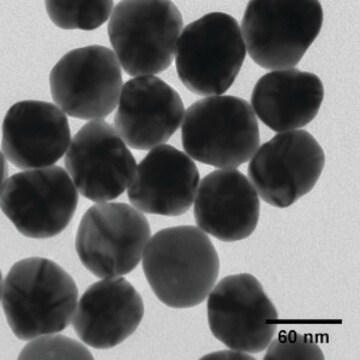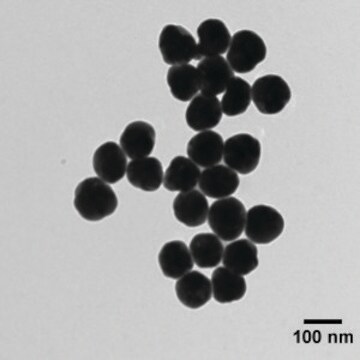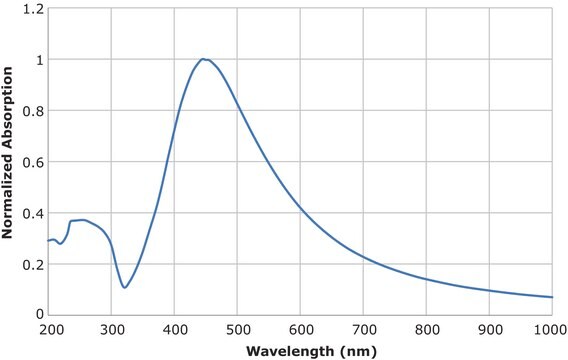730793
Silver, dispersion
nanoparticles, 20 nm particle size (TEM), 0.02 mg/mL in aqueous buffer, contains sodium citrate as stabilizer
Synonim(y):
Srebro koloidalne
About This Item
Polecane produkty
Formularz
nanoparticles
Poziom jakości
zawiera
sodium citrate as stabilizer
stężenie
0.02 mg/mL in aqueous buffer
współczynnik refrakcji
n20/D 1.333
wielkość cząstki
20 nm (TEM)
gęstość
0.986 g/mL at 25 °C
fluorescencja
λem 401 nm FWHM 66 nm
temp. przechowywania
2-8°C
ciąg SMILES
[Ag]
InChI
1S/Ag
Klucz InChI
BQCADISMDOOEFD-UHFFFAOYSA-N
Szukasz podobnych produktów? Odwiedź Przewodnik dotyczący porównywania produktów
Powiązane kategorie
Opis ogólny
Zastosowanie
- Powierzchniowo wzmocniona analiza ramanowska leków sulfonamidowych na koloidalnej dyspersji srebra...: W niniejszym badaniu zbadano zastosowanie koloidalnej dyspersji srebra do analizy leków sulfonamidowych metodą powierzchniowo wzmocnionego rozpraszania Ramana (SERS). Badanie demonstruje potencjał nanocząstek srebra we wzmacnianiu sygnałów ramanowskich, co czyni je cenną techniką wykrywania i analizy farmaceutyków w niskich stężeniach (Sutherland et al., 1990).
Hasło ostrzegawcze
Warning
Zwroty wskazujące rodzaj zagrożenia
Zwroty wskazujące środki ostrożności
Klasyfikacja zagrożeń
Aquatic Acute 1 - Aquatic Chronic 1
Kod klasy składowania
12 - Non Combustible Liquids
Klasa zagrożenia wodnego (WGK)
WGK 3
Temperatura zapłonu (°F)
Not applicable
Temperatura zapłonu (°C)
Not applicable
Wybierz jedną z najnowszych wersji:
Masz już ten produkt?
Dokumenty związane z niedawno zakupionymi produktami zostały zamieszczone w Bibliotece dokumentów.
Produkty
A key challenge for nanomaterial safety assessment is the ability to handle the large number of newly engineered nanomaterials (ENMs), including developing cost-effective methods that can be used for hazard screening.
Silver nanomaterials have unique physical, chemical, and optical properties that are currently being leveraged for a wide variety of biological applications.
Nanomateriały srebra mają unikalne właściwości fizyczne, chemiczne i optyczne, które są obecnie wykorzystywane w wielu różnych zastosowaniach biologicznych.
Nanostructured Materials Through Ultrasonic Spray Pyrolysis
Global Trade Item Number
| SKU | GTIN |
|---|---|
| 730793-25ML | 4061832865300 |
Nasz zespół naukowców ma doświadczenie we wszystkich obszarach badań, w tym w naukach przyrodniczych, materiałoznawstwie, syntezie chemicznej, chromatografii, analityce i wielu innych dziedzinach.
Skontaktuj się z zespołem ds. pomocy technicznej








